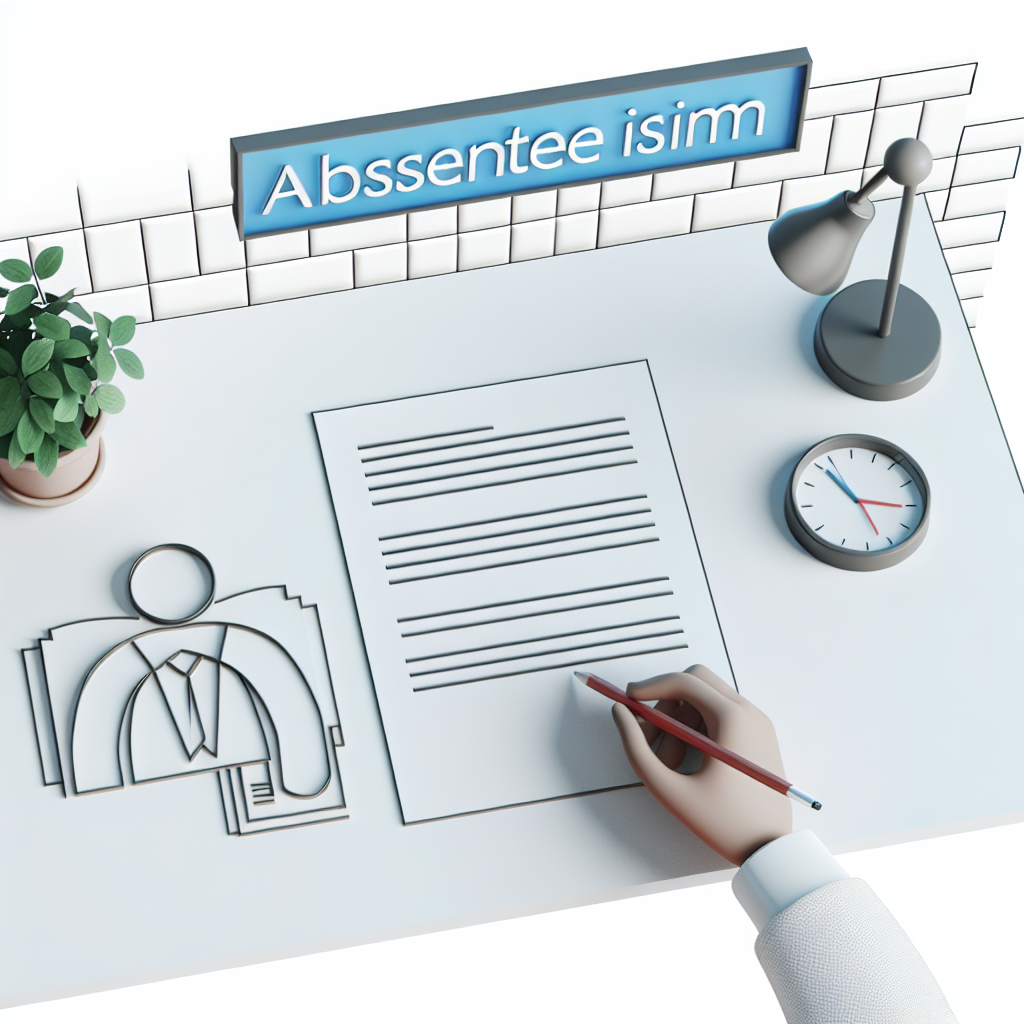
In today’s fast-paced work environment, the documentation of absence due to varied reasons remains a paramount concern for both employees and employers. An absenteeism letter plays an essential role in this communications process, serving as a formal notification while cultivating an atmosphere of transparency within the workplace. This article outlines essential guidelines for writing effective absenteeism letters, highlights their significance, discusses current trends, and examines the benefits that are up for grabs when organisations implement clear absenteeism policies.
The Significance of an Absenteeism Letter
An absenteeism letter is not just a mere formality; it is a crucial document in maintaining effective communication within the workplace. The importance of this letter stems from its ability to:
- Document Absences: Whether the absence is due to illness, family emergencies, or personal matters, an absenteeism letter serves to formally notify employers. This helps in maintaining written records, which can be valuable for both parties.
- Promote Transparency: By outlining the reason for absence, it fosters a climate of openness that can help maintain trust between employees and their employers.
- Ensure Compliance: Many companies have established policies regarding absenteeism. Sending a formal letter can be vital in adhering to these standards and upholding labour laws.
How to Write an Absenteeism Letter
Writing an absenteeism letter may seem straightforward, but attention to detail is essential. Below is a step-by-step guide to help employees craft a clear and effective letter.
1. Subject Line
The subject line should immediately clarify the letter’s intent. For example, use “Notification of Absence Due to Illness” to provide context right away.
2. Introduction
Start by introducing oneself and specifying the date of the letter. This sets a formal tone from the outset.
3. Reason for Absence
Clearly articulate the reason for your absence. If the absence is due to health reasons, provide a succinct description while respecting privacy.
4. Duration of Absence
Include the start and end dates of your absence. This gives the employer an understanding of the timeframe involved.
5. Supporting Documentation
If relevant, mention any supporting documents that accompany the letter, such as a medical certificate. This adds credibility to the absence.
6. Contact Information
Providing contact details is helpful in case the employer requires further information.
7. Closing
Close the letter with a thank you for understanding and include your signature, further cementing a respectful tone.
Example Absenteeism Letter
Here’s how a completed absenteeism letter may look:
[Your Name] [Your Address] [City, Postcode] [Email Address] [Phone Number] [Date] [Employer’s Name] [Employer’s Title] [Company Name] [Company Address] [City, Postcode] Subject: Notification of Absence Due to Illness Dear [Employer’s Name], I hope this letter finds you well. I am writing to inform you that I will be absent from work from [start date] to [end date] due to illness. I have attached a medical certificate to support my absence. Please let me know if any further information is required. Thank you for your understanding. Yours sincerely, [Your Signature] [Your Full Name]
Current Trends in Absenteeism Management
The dynamics of work are consistently shifting, which has led to several notable trends when it comes to absenteeism management. Understanding these trends is pivotal for HR professionals aiming to enhance workplace culture and communication.
1. Digitalising Absenteeism Reports
With the surge in remote working and technological integration into everyday tasks, there is a marked shift towards digital absenteeism reporting. This modern approach not only streamlines the communication process but also makes it more convenient and efficient for both employees and employers.
2. Focus on Employee Well-being
There’s an increasing emphasis on understanding the factors behind absenteeism, particularly those relating to mental health. Employers are now being encouraged to cultivate supportive workplaces that invite candid discussions about well-being. By tackling mental health head-on, organizations can help in significantly reducing incidences of absenteeism.
3. Flexible Work Arrangements
The adoption of flexible working schedules accommodates employees who may otherwise find it challenging to balance personal commitments and work. By embracing these arrangements, employers reduce stress levels, which can lead to lower absenteeism rates.
Key Benefits of Writing an Absenteeism Letter
The proactive approach of writing an absenteeism letter comes with numerous benefits, which can significantly impact workplace dynamics:
- Transparency: An absenteeism letter aids in fostering trust by ensuring that both parties are aware of the reasons behind an employee’s absence.
- Compliance: Ensuring that absenteeism is formally documented helps organisations comply with established policies and local labour laws, thereby reducing potential disputes.
- Enhanced Efficiency: Digital solutions for absenteeism reporting enhance efficiency, making it more straightforward to manage resources and workload.
- Cultivating a Supportive Environment: Providing proof of absence, like medical certificates, nurtures a culture where employees feel comfortable addressing health issues without fear of judgement.
Conclusion
A well-crafted absenteeism letter is not only essential for keeping employers informed but also aids in upholding a transparent and trusting work atmosphere. As trends evolve towards digitalisation and a stronger emphasis on well-being, it is crucial for HR professionals to adapt their strategies to effectively communicate with their workforce. Embracing these changes will contribute significantly to reducing absenteeism, enhancing employee satisfaction, and ultimately leading to a more productive work environment.
To explore further insights into reducing absenteeism and fortifying workplace culture, consider consulting resources such as X-Playn which outlines best practices and correlations between job satisfaction and absenteeism.
In conclusion, the ability to communicate effectively regarding absences is fundamental in today’s workplace. By harnessing the insights outlined in this article, HR professionals can not only foster a sense of community and support within their organisations but also promote a healthier work-life balance for all employees.
Vadim Kouznetsov is a distinguished entrepreneur and the visionary founder and CEO of JobXDubai.com, the UAE’s rapidly expanding job board. Renowned for his expertise in bridging the gap between job seekers and employment opportunities, Vadim has become a leading authority in the recruitment and job market of Dubai.
